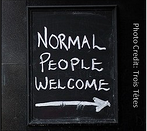Nerd Alert - Monacle Not Required, But....
In our last two pieces on Gamification, we focused on some lighter topics that were fun to take in and think  about. Namely, the surprising history of Gamification and a special case study from SAP (and in both cases, offered a free eBook of 7 Great Examples).
about. Namely, the surprising history of Gamification and a special case study from SAP (and in both cases, offered a free eBook of 7 Great Examples).
Today however, we're going deep! Deep into the human brain where we'll learn what is behind the success of gamification. Given that we've previously seen how it has historically been successful even before the digital age, it is not surprising to learn that we are, after all, apparently wired for it....
"Professional" is Another Word for "Boring"
Much of the advertising business has always been about discovering the emotion that matters most relative to the target audience and the product or service being sold. For many industries in many traditional channels, the primary emotion being leveraged is fear. As in "if you don't use our product, then THIS will happen to you" or "Do you know if your's is really OK? Find out with our product."
Gamification, on the other hand, plays upon our emotional need to have fun. We are drawn to do fun things, and if we can make the mundane, dull or otherwise fearsome task into a fun one, the theory is that we not only get more participation, but that the participation we do get is of higher quality from improved attention spans and a pro-active desire to participate, not one driven by fear.
In an interview for Information Week, Gabe Zicherman, co-author of "Gamification by Design" noted: "If you can make something more fun, and include notions of play, you can get people to do things they otherwise might not want to do."
One important note that comes out of Zicherman's work is to remember that Gamification is NOT just about Marketing. Citing examples where Google has used it internally to reduce travel expenses and Target to improve cashier performance, Zicherman makes the case that Gamificaiton is really about the "psychology of engagement".
"The Psychology of Engagement" = "The Science of Motivation"
Michael Wu, Ph.D. the Principal Scientist of Analytics at Lithosphere has assembled an in-depth look at the psychology theory behind what makes Gamification work. Drawing on the work of Abraham Maslow, Dan Pink and finally, B.F. Skinner, he maps out how the differing theories overlap as well as break new ground in understanding Motivation and concludes that in order for gamification to be successful, there are certain elements of complexity required:
and finally, B.F. Skinner, he maps out how the differing theories overlap as well as break new ground in understanding Motivation and concludes that in order for gamification to be successful, there are certain elements of complexity required:
- People are motivated by innate needs, so any attempts at true engagement needs to both recognize them and demonstrate an ability to meet them.
- A simplistic rewards model (i.e. using a "points-only" system) will work, but only temporarily before users get bored and move on.
- Engagement needs to draw a fine line between certainty and uncertainty.
- Gamification needs to adapt to your audience's evolving skill level in order to maintain motivation.
In other words, it’s critical to develop a gamification plan that is based on understanding your audience’s motivations and understanding that those motivations are not always going to be one-dimensional.
Making it Work For Your Brand
So how does your Brand leverage this technique to maximum effect?
For example, you might have a points system for a certain behavior, perhaps”downloads” of your content, samples, trials, etc. But it would then make sense to have additional types of content worth different amounts of points or a different reward altogether, like educational materials or coupons or registering for new services (Starbucks user accounts mix this up well with rewards for adding FREE services in addition to purchasing drinks and food). Finally, consider putting your offers into tiers where some are only unlocked after a certain number of points are accumulated or activities have been accomplished. Building some complexity into the gamification structure will ensure an extended engagement that avoids becoming boring too quickly.
And like a professional direct or digital marketing plan, observe, learn and react according to the engagement patterns of your users. We now have the tools in our hands that allow us to continuously optimize and improve upon our offerings to our audiences. And in the end, that is perhaps the key - to think of what you put out there as an "offer" and not a "gimmick", because ultimately it is the compelling offer that motivates a prospect to ask for more.
See how Gamification is working across different industries and the techniques for getting it done in our new e-Book "Gamification in B2B Marketing is About Addiction, Not Games."



